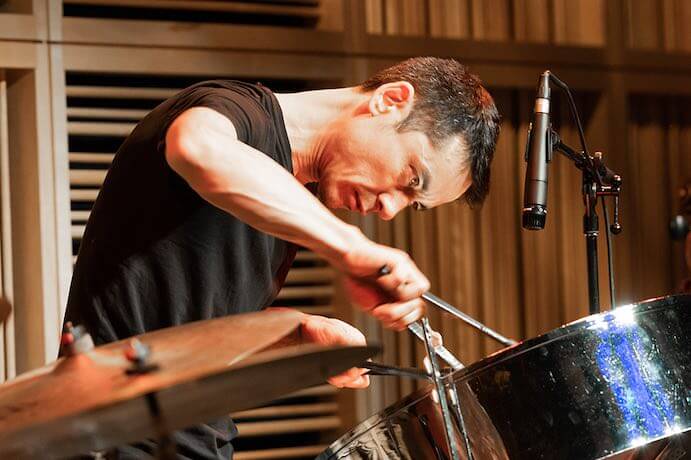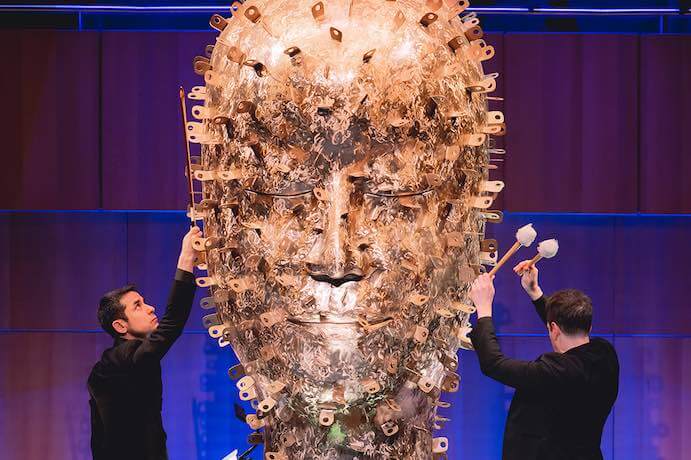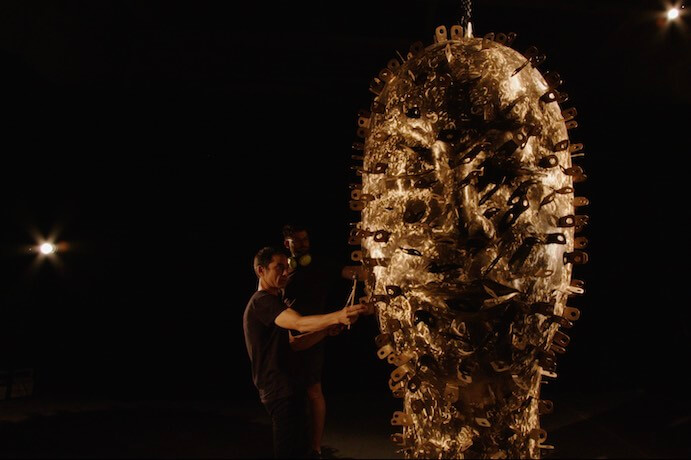A massive bronze head, with loops jutting out from every crevice of its face, sits amongst the orchestra at The Holland Performing Arts Center, in Omaha, Neb. Though it may not look like it at first glance, the glimmering sculpture, created by Jun Kaneko, is another instrument waiting to be played, a cavernous object that holds within it a psychedelic spectrum of sound.
Composer and percussionist Andy Akiho has spent the better part of a year playing this head and other works by Kaneko, getting to know their pitches and textures. His piece Sculptures, which premiered at the Holland on March 17 and 18, reacts to and implements Kaneko’s art in nine evocative movements that seesaw between orchestra, video, and live sculpture playing. It was commissioned as part of the Omaha Symphony’s annual gala, which honored Kaneko and his wife Ree with the Dick and Mary Holland Leadership Award.
Kaneko is a giant in Omaha’s art scene, known for his incredibly large, vibrantly colored works. He has created thousands of pieces of all different shapes and sizes, using mediums like ceramics, bronze, and glass. His artistic touch can be felt all over the city: Gene Leahy Mall, a recently renovated park across the street from The Holland, hosts a bright yellow head, and he’s designed costumes and visuals for outfits like the Omaha Opera.

Andy Akiho — Photo by Da Ping Luo
The sheer mass and scale of Kaneko’s practice drew Akiho from the beginning — to him, Kaneko’s sculptures feel like an otherworldly feat. “It’s like magic… it’s defying physics a little bit and getting this beautiful art at the same time,” Akiho said on a phone call before the concert.
Akiho has long enjoyed writing collaborative music. Works like Seven Pillars (2022), which was a Pulitzer Prize finalist, exemplify his multidisciplinary style — the piece was created with Sandbox Percussion and it’s a video-music combination experience. Working with artists across genres and mediums has always served as a point of inspiration for Akiho, a way of discovering things he may never have thought of before. “I need that energy,” he said. “Being around people is how I thrive and get energy to write better and to come up with better ideas.”
He also lets himself get fully immersed in all of his senses when working. “How I like to experience is just to dive right in,” he said. He became engrossed in Kaneko’s practice, even venturing inside of the sculptor’s humongous kiln and lighting it up (with the door open, of course). He’s spent painstaking hours bowing and tapping Kaneko’s works, unearthing the pitches inside of them. To Akiho, any object is capable of making music, and he’s down to give it a shot.
Though Akiho writes music, his compositions are visual, often growing out of his synesthetic experiences with sound. “I see it more than I hear it, sometimes,” he said over coffee at Hardy Coffee Co., his regular coffee shop in Omaha. Akiho first discovered his synesthesia in 2002 on a trip to Trinidad. He was playing the steel pan, and every time he played the note D, he saw orange. He didn’t know he could be synesthetic at the time — he doesn’t have perfect pitch or anything of the like — but over time, more colors began to reveal themselves, especially as he improvised in jazz settings. “It’s almost like paint by number,” he said. A C-sharp diminished chord looked purple; an F-major seven looked red. If he played 32nd notes, a flurry of colors would flash by.

Andy Akiho — Photo by Casey Wood
Throughout the process of composing Sculptures, Akiho tapped into these visuals. As he played Kaneko’s pieces, he determined their pitches through color associations and labeled them. He kept coming back to green, but he couldn’t think of a work by Kaneko that’s totally green — only one or two might have a green stripe or polka dot. It was as if he were filling in a missing shade.
The visuals manifest throughout Sculptures in other ways, too. Akiho is giddy as he recalls making “Ma,” a pre-recorded video of him and Kaneko playing artworks. His voice speeds up as he describes placing the clay sculptures in a semicircle, beating different rhythms on each piece. He later wove these fragments together in Final Cut Pro.
In live performance, Sculptures captivates the senses. Before each movement begins, images of the sculptures that inspired it are projected on a screen above the orchestra, setting the mood. The orchestral movements take on a more metaphorical approach, acting as meditations that evoke the colors and textures of Kaneko’s pieces, while the video and percussion movements show us directly what the artworks look and sound like. In movements like “Translucent,” inspired by Kaneko’s glass sculptures, the orchestra plays a buoyant melody that balances fast-paced action and light plucks, evoking the transparency of glass. With “Density,” the players strike a thick chord, creating a rich drone that holds the weight of one of Kaneko’s chunky ceramics.

Andy Akiho performs “Sculptures” with the Omaha Symphony, featuring a large bronze head created by Jun Kaneko — Photo by Casey Wood
At other points, Akiho and another percussionist climb onstage and hit the bronze head with mallets and bows. Its metallic reverberation creates a hum that rings throughout the hall. “Bronze I” takes a pensive stance, meditating on the array of droning overtones from the head, while “Bronze II” is a flickering rhythmic lattice. Each tab that sticks out from the head represents a different note, and the way you play it might yield a different type of sound. You can bow the top of the tab or its sides, you can pull the bow softly or harshly against it — any small shift will offer a different timbre.
Though these first performances of Sculptures were performed with Kaneko’s works on hand, Akiho is making the piece playable without the sculptures (or without him playing them). The goal is to make music that speaks beyond its inspirations. “It exists not just because it’s a new thing happening… if there were no sculptures involved, or if [the audience is] just hearing it without seeing anything, I want them to be able to feel it,” he said. The process is about finding music wherever it lives, even in the most unexpected places. In Akiho’s words: “I let the music and the sculptures speak for themselves.”
I CARE IF YOU LISTEN is an editorially-independent program of the American Composers Forum, and is made possible thanks to generous donor and institutional support. Opinions expressed are solely those of the author and may not represent the views of ICIYL or ACF.
You can support the work of ICIYL with a tax-deductible gift to ACF. For more on ACF, visit the “At ACF” section or composersforum.org.























